One thing we can thank our
house-building ancestors for is the frequent incorporation into house
frontages of name (and, sometimes, date) plaques. The Derby Road end of
Rosehill Road
provides some interesting examples.
Rosehill Road
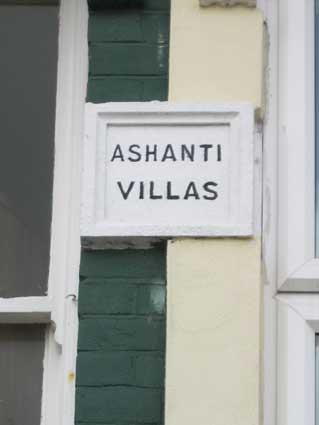 2013
images
2013
images
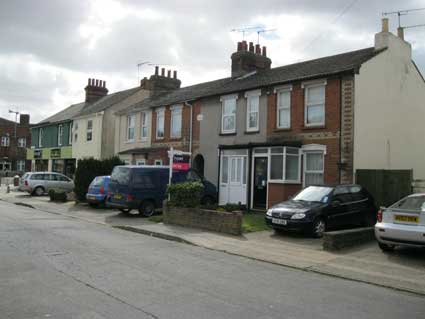
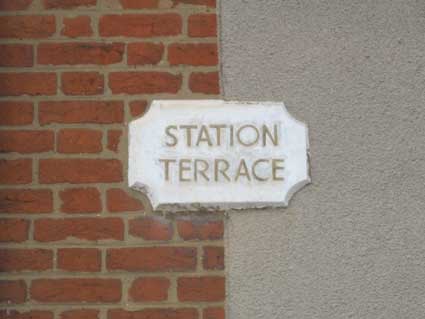
The street scene above shows Rosehill Primary School at far left, Ashanti Villas with, two doors down at number 202-204, the name plaque in typical cartouche style:
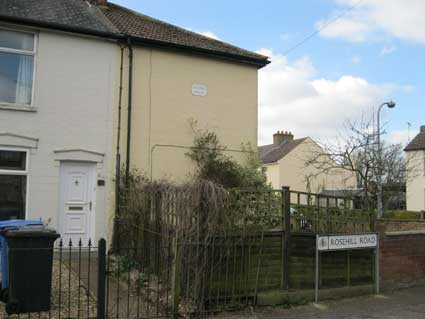
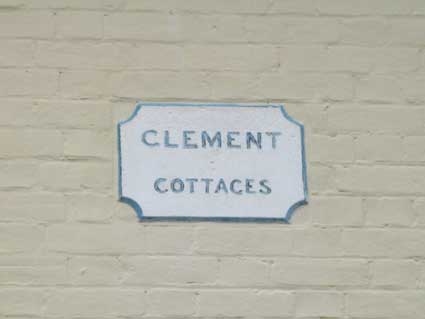
Finishing off this little one-way stretch of Rosehill Road and on the corner with York Road is a much older-looking house name. It bears smaller characters and is, oddly, on the side wall of dwellings at 66 York Road:
House name plaque examples: Alston Road; Bramford Road; Broom Hill Road; Burlington Road; Cauldwell Hall Road; Cavendish Street; Marlborough Road
Rosehill Library case study; Rosehill churches;
Ipswich & Suffolk Freehold Land Society (F.L.S.); California;
Street index; Origins of street names in Ipswich; Streets named after slavery abolitionists;
Dated buildings list; Dated buildings examples;
Named buildings list; Named (& sometimes dated) buildings examples;
Street nameplate examples; Brickyards.
Home
©2004 Copyright
throughout the Ipswich
Historic Lettering site: Borin Van Loon
No reproduction of text or images without express written permission
Rosehill Road
 2013
images
2013
images'ASHANTI
VILLAS'
VILLAS'
An unusual boxed name plaque sits
between two windows between the pine furniture shop on the corner
and the adjoining house (208-210 Rosehill Road). So why
is a nineties R&B
singer celebrated by this house name? OK, not Ashanti Douglas, then.
The Ashanti (or Asante) Empire (or Confederacy), also Asanteman
(1701–1957), was a West Africa sovereign state of the Ashanti people of
Ashanti, Ghana. It demonstrates the unusual sources used for house
names in the very colonial Victorian era.


The street scene above shows Rosehill Primary School at far left, Ashanti Villas with, two doors down at number 202-204, the name plaque in typical cartouche style:
'STATION
TERRACE'
Yes, Ipswich does have a second railway station. Somewhat
similar to Colchester Town station, but not half as well looked after.
Nearby Derby Road Station is celebrated on this name plaque about 200
yards away from it. The station was built to serve the suburb of
California, now generally called "St John's", and stands on the Ipswich
to Felixstowe line described in more detail on our railway bridges page. In
2014 the station is in urgent need of a makeover, having lost its
platform canopy and many fittings and being largely boarded up.TERRACE'


Finishing off this little one-way stretch of Rosehill Road and on the corner with York Road is a much older-looking house name. It bears smaller characters and is, oddly, on the side wall of dwellings at 66 York Road:
'CLEMENT
COTTAGES'
Related pages:COTTAGES'
For information on Rosehill Library in nearby Tomline Road and
the story of the area see our Rosehill
case study page. For information on the churches in the area, see
our Rosehill churches page.
[UPDATE 26.3.2012: 'Came across your site recently, it's fascinating, I lived in Rosehill Rd up to a couple of years ago & often wondered about the plaques on the houses of the area & the history behind them. I thought I might find something on the plaque that's on 174 Rosehill Road (where I lived) "Alpha Place 1875".... have you come across this? Kind regards, Keith Turnbull. Thanks to Keith for the suggestion. We hadn't noticed this because it's so difficult to read from the street.]
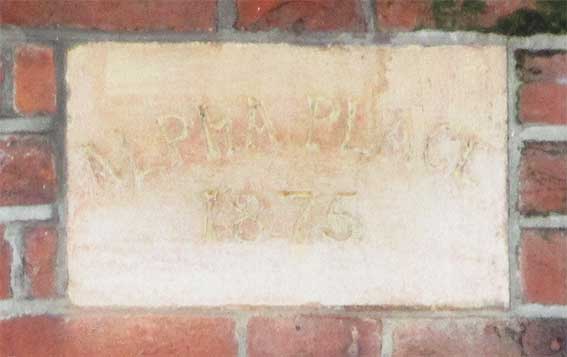
Above is a retouched close-up revealing that the incised, decorative characters were once lined in black, but appear to have been filled with a buff paint. Odd thing to do.
Upper Cavendish Street
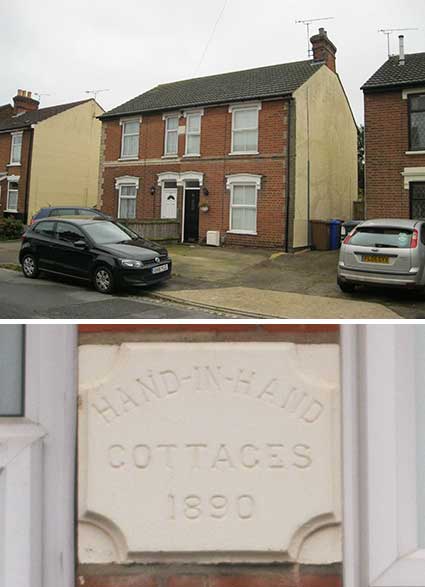 2016
images
2016
images
58-60 Upper Cavendish Street
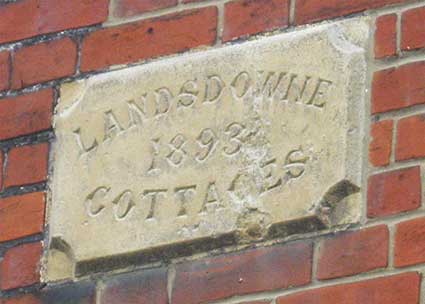 2017
image
2017
image
40-42 Upper Cavendish Street
The missing name plaque
On the subject of house name plaques, it is worthy of note that every now and then we come across a house frontage where an owner (or perhaps both owners) have removed the stone tablet from the fabric of the front of the building and infilled with matching brick. To go to such expense and trouble suggests that they must have taken great exception to the house name. One such example is at 17-19 Upper Cavendish Street.

York Road
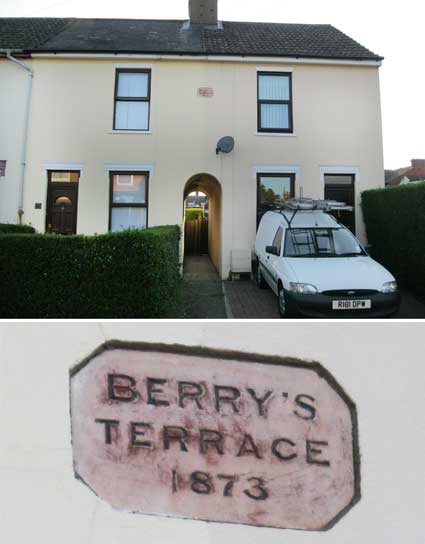
61-63 York Road.
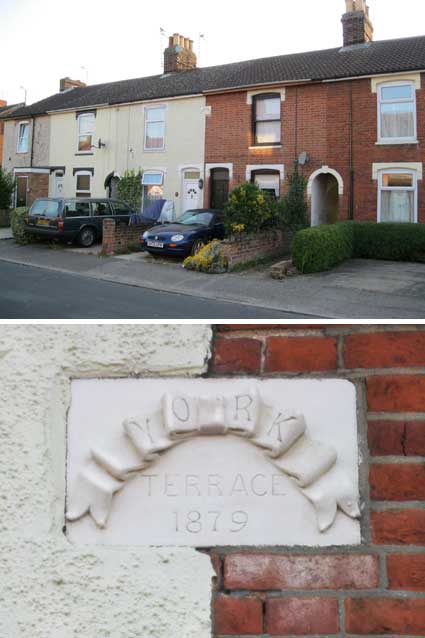
11-13 York Road.
Newton Road
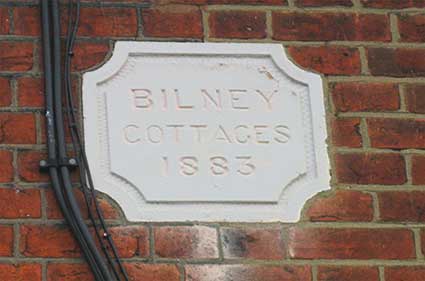 2017 images
2017 images
5-7 Newton Road
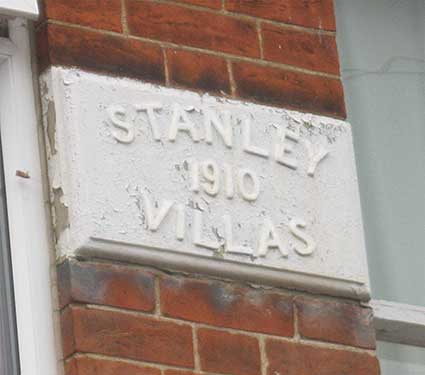
12-14 Newton Road

18-20 Newton Road
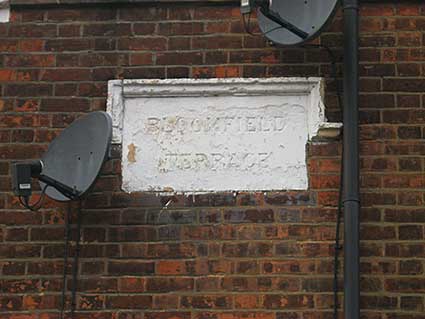
64-66 Newton Road
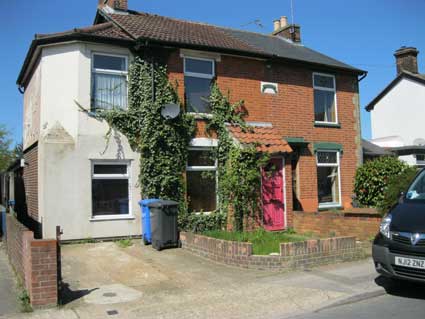
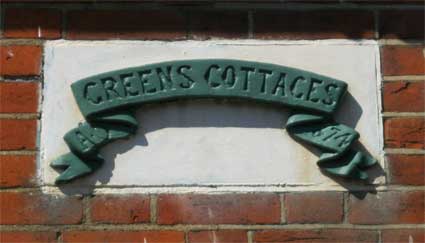 2013 images
2013 images
80 Newton Road.
Foxhall Road
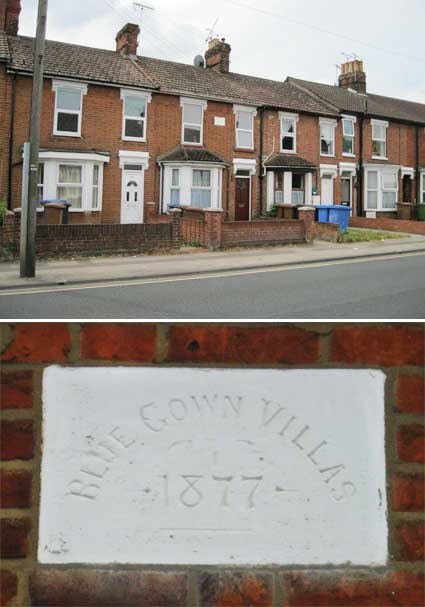 2013 images
2013 images
142 Foxhall Road is part of a Victorian terrace with the most intriguing name in a decorative script:

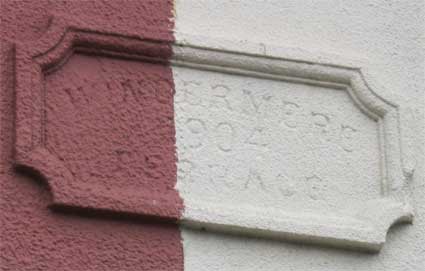
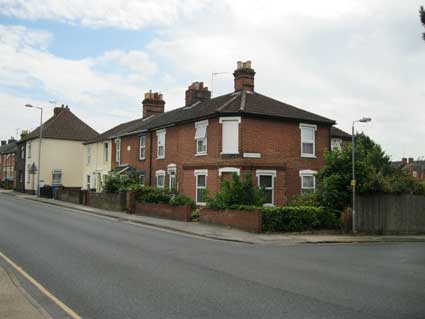
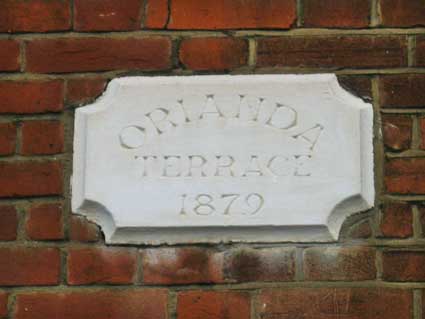
On 174 Foxhall Road can be found another cartouche with the finely chiselled lettering:
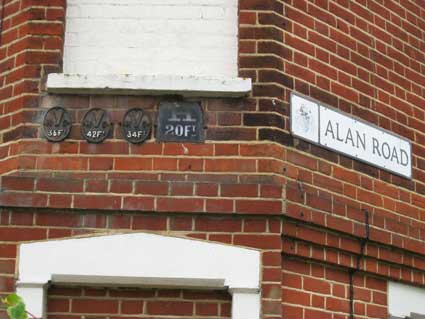

170 Foxhall Road is at one end of Orianda Terrace, on the corner with Alan Road (see Street name derivations for a link to the Cobbold dynasty). This building used to be a greengrocery shop with its doorway on the 45 degree angled corner. A sign was painted in the blank window above. Between the two the owner has fixed his collection of hydrant signs (see Street furniture). They indicate the position of valves on the water mains and are of late nineteenth or twentieth century date and other examples used to visible in Bridge Street. The enamelled hydrant sign on the right is similar to that seen in Soane Street.
Alan Road
That Alan Road street nameplate (above) can be contrasted with the sign on the corner of Cavendish Street, as spotted by Simon Bole (21.1.2016):
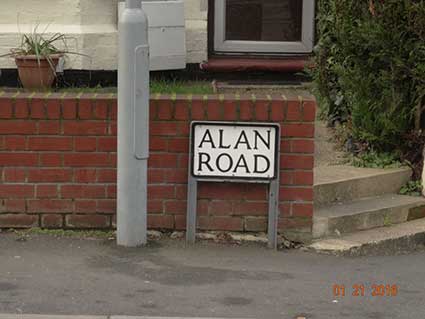 2016 image
2016 image
"I really enjoyed the talk last night, it made me realise that I am not alone in admiring what amounts to 'street furniture'. I had seen your website in advance of the talk and found both fascinating... Alan Road: The street nameplate at the corner of Cavendish St is at low level on the back edge of the footpath rather than on the house. More quirkily the word 'Alan' is positioned above 'Road'. I attach a photo. Simon B." Perfect spacing of the two words – thanks, Simon.
See Margaret Hancock's research on the origins of the Rosehill Estate and the derivation of the name 'Alan Road'.
Regent Terrace, 55-57 Alan Road
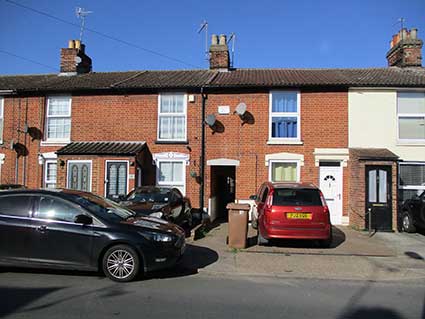
 2021 images
2021 images
Further up Foxhall Road on the corner with Newton Road is 'TENNYSON HOUSE 1892' with the name plaque at the centre of the side gable on Newton Road, rather than above the front door (see Clement Cottages, above). Alfred Tennyson, 1st Baron Tennyson, FRS (1809 – 1892) was Poet Laureate of Great Britain and Ireland during much of Queen Victoria's reign and this tablet commemorates the year of his death. Perhaps appropriately, at some time after this 2013 photograph was taken the owners painted the tablet black, with the characters white.
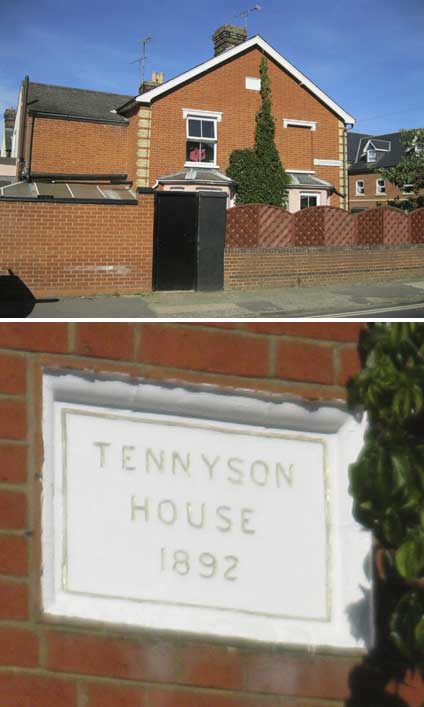
Derby Road
A row of houses on the east side of the road leading up to the 'Family Grocer' lettering displays some unexpected house names. Sydney Cottages are at nos. 79-81.
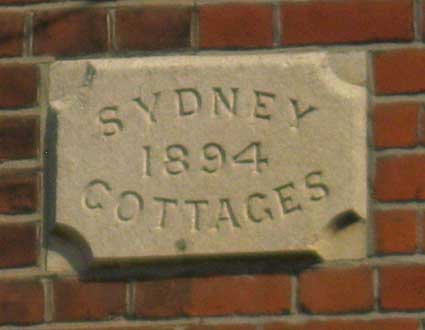
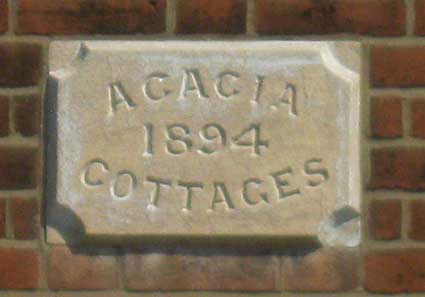 2013
images
2013
images


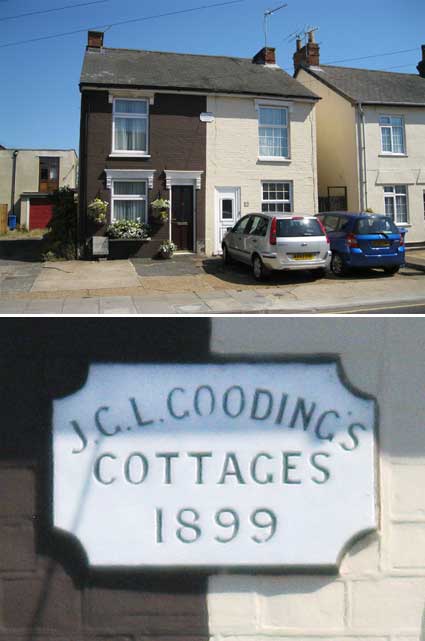
[UPDATE 29.3.2016: 'Just spent a happy half hour having a look into above. Not guaranteed but I suspect JGL Gooding was owner/landlord of The Royal Oak public house.
Plots of land fronting Derby Road were included on FLS Felixstowe Road Estate No 4 offered to its members in July 1889 as "the final portion of the Estate of 74 acres situate on the Felixstowe and Derby Roads and which has proved... to be one of the most successful ever dealt with by the Society". This ballot notice (IRO Ref:Gf419/FLS1849/3/1/1/64) also lists the other portions of the Estate balloted in earlier years. Roughly speaking the 74 acres covered the section of Felixstowe Road from Derby Road to the west side of the present Bixley Road.
FLS Felixstowe Road Estate No 4 was balloted in 3 portions:
1st Ballot - Stanley House (which has recently been thoroughly repaired), with Yard, Stables, Sheds & Gardens situate at the corner of Felixstowe and Derby Roads
2nd Ballot - Six Houses with an acre of land to each on the Felixstowe Road and Two Houses with 130 rods of land to each on the Derby Road
3rd Ballot - Fifteen most eligible Plots of Building Land with frontages on the Derby Road.
Plot 15 was adjacent to Stanley House and a purchase contract dated 21st August 1889 (IRO Ref GF419/FLS1849/3/1/11/2) reveals that it was originally balloted to James Durham but his name is crossed through & the name J Gooding, Royal Oak inserted. The price of the plot was £49.
Hope you find this as interesting as I do!! Margaret.' We are very grateful to the official archivist of Ipswich Building Society for this information from their records.]
See also Margaret Hancock's research on the Rose Hill area, including Cyclamen Cottages, Bateman's Villa, Emmeline Cottage, Adela Cottages.
See also our Lettered castings index page.
[UPDATE 26.3.2012: 'Came across your site recently, it's fascinating, I lived in Rosehill Rd up to a couple of years ago & often wondered about the plaques on the houses of the area & the history behind them. I thought I might find something on the plaque that's on 174 Rosehill Road (where I lived) "Alpha Place 1875".... have you come across this? Kind regards, Keith Turnbull. Thanks to Keith for the suggestion. We hadn't noticed this because it's so difficult to read from the street.]
'ALPHA PLACE
1875'
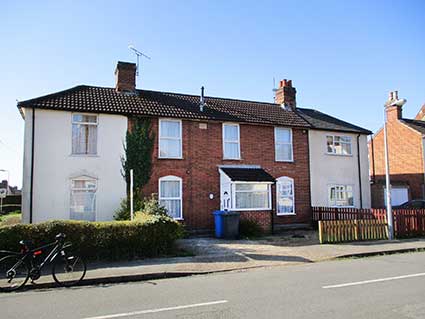
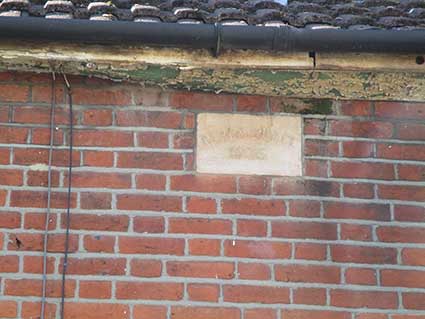 2021
images
2021
images
We would have guessed that the name was chosen just because it has a ring to it. However, 1875 is quite an early date. Is it possible that this was the first house built there, hence the name, alpha being the first letter of the Greek alphabet? The short terrace on the corner of York Road is shown above; No. 174 apparently built be bigger that its book-ending neighbours. The three are quite modest and plain in design, suggesting an early build. Also the houses here, from the corner down to the site of St Bartholomew’s Church, were built by the Ipswich & Suffolk Freehold Land Society, so it’s looking promising. Surrounding houses, where dated, appear to be later – for example, the first three shown at the top of the page, which are undated.
1875'

 2021
images
2021
imagesWe would have guessed that the name was chosen just because it has a ring to it. However, 1875 is quite an early date. Is it possible that this was the first house built there, hence the name, alpha being the first letter of the Greek alphabet? The short terrace on the corner of York Road is shown above; No. 174 apparently built be bigger that its book-ending neighbours. The three are quite modest and plain in design, suggesting an early build. Also the houses here, from the corner down to the site of St Bartholomew’s Church, were built by the Ipswich & Suffolk Freehold Land Society, so it’s looking promising. Surrounding houses, where dated, appear to be later – for example, the first three shown at the top of the page, which are undated.

Above is a retouched close-up revealing that the incised, decorative characters were once lined in black, but appear to have been filled with a buff paint. Odd thing to do.
Upper Cavendish Street
 2016
images
2016
images58-60 Upper Cavendish Street
'HAND-IN-HAND
COTTAGES
1890'
COTTAGES
1890'
 2017
image
2017
image40-42 Upper Cavendish Street
'LANDSDOWNE
1893
COTTAGES'
There is a title of Marquis of Landsdowne. (two 'd's). No
known connection with William Cavendish, Duke of Devonshire, but
wouldn't that be neat? See also Cavendish Street.1893
COTTAGES'
The missing name plaque
On the subject of house name plaques, it is worthy of note that every now and then we come across a house frontage where an owner (or perhaps both owners) have removed the stone tablet from the fabric of the front of the building and infilled with matching brick. To go to such expense and trouble suggests that they must have taken great exception to the house name. One such example is at 17-19 Upper Cavendish Street.

York Road

61-63 York Road.
'BERRY'S
TERRACE
1873'
Alexander Berry (1781-1873) was a Scottish-born surgeon,
merchant and explorer and one of the founders of the state of New South
Wales, died in Sydney Australia on 17 September 1873. In
1822 he was given a land grant of 10,000 acres and 100 convicts to
establish the first European settlement on the south coast of New South
Wales, Australia. There are no known links to Ipswich or Suffolk, but
it is likely that the death of a notable person in the news gave rise
to this naming.TERRACE
1873'

11-13 York Road.
'YORK
TERRACE
1879'
Queen Victoria's second grandson, George Ernest Frederick Albert
(1865-1936), became Duke of York on 24 May 1892, became King George V
in 1910 and remained so through the First World War until his death on
20 January 1936. George was only 17 months younger than Albert Victor,
and the two princes were educated together. in September 1877, when
George was twelve years old, both brothers joined the cadet training
ship HMS Britannia at Dartmouth, Devon. For three years from 1879, the
royal brothers served on HMS Bacchante, accompanied by their tutor,
John Neale Dalton. Whether any of this was in the mind of the
house-namer here, we cannot know, but the unusual 'tied-up-with-a-bow'
pleated scroll on this name plaque compares with Percy Cottages and Clarence House.TERRACE
1879'
Newton Road
 2017 images
2017 images5-7 Newton Road
'BILNEY
COTTAGES
1883'
It is likely that this name relates to the first owner, as in
the case of Clement Cottages, J.G.L. Gooding's Cottages (on this page)
and Bateman's Villa, also in Newton Road, shown on the page including Margaret Hancock's research.COTTAGES
1883'

12-14 Newton Road
'STANLEY
1910
VILLAS'
An unusual house name plaque, this. The characters stand in
relief from the surface (cameo, unlike almost all other plaques shown
on this website where the letters are incised (intaglio); were the
letters applied later, or was the plaque moulded as in the case of
almost all others? (The exception in Salisbury Terrace in Woodbridge
Road, shown on our Named buildings
page, which is made out of wood and bears incised characters.1910
VILLAS'

18-20 Newton Road
'ORWELL
COTTAGES
1877
S H'
The out-of-the ordinary addition of initials suggests those of
the first owner of the property; see (Bilney Cottages above). The
naming after the larger of the Ipswich rivers is obvious.COTTAGES
1877
S H'

64-66 Newton Road
'BLOOMFIELD
TERRACE'
This very large and degraded name plaque can be found opposite
the Church of St Bartholomew. Bloomfield is a name found on the F.L.S. California estate;
see our Street name derivations page
for Bloomfield Street. Perhaps they are related.TERRACE'

 2013 images
2013 images80 Newton Road.
'GREENS COTTAGES
A.D ... 1874'
See our list of occupants of no. 170 Newton Road ('E. Markham: County Supply Stores') for mention
of the source of this house name from 1904.A.D ... 1874'
... the scroll with the waggly
tails.
Foxhall Road
 2013 images
2013 images142 Foxhall Road is part of a Victorian terrace with the most intriguing name in a decorative script:
'BLUE GOWN VILLAS
1877'
1877'
The delight of apparently
insignificant historical detail is the question it poses.


'WINDERMERE
1904
TERRACE'
1904
TERRACE'
Above the alleyway between 137
and 139 Foxhall Road. In their peerless work The doughnut in Granny's greenhouse
by The Bonzo Dog Doo-Dah Band lead singer and trumpeter Vivian
Stanshall intones the swingin' number My pink half of
the drainpipe. The images recall that portrait of suburban life.
The roughcast spattered all over the name plaque cartouche hasn't quite
obliterated the lettering.


On 174 Foxhall Road can be found another cartouche with the finely chiselled lettering:
'ORIANDA TERRACE
1879'
1879'
Orianda is a resort town on the
southern shores of the Crimea, a peninsula of Ukraine located on the
northern coast of the Black Sea. The Crimean War ran from October 1853
– February 1856 so the name of this building may relate to that.


170 Foxhall Road is at one end of Orianda Terrace, on the corner with Alan Road (see Street name derivations for a link to the Cobbold dynasty). This building used to be a greengrocery shop with its doorway on the 45 degree angled corner. A sign was painted in the blank window above. Between the two the owner has fixed his collection of hydrant signs (see Street furniture). They indicate the position of valves on the water mains and are of late nineteenth or twentieth century date and other examples used to visible in Bridge Street. The enamelled hydrant sign on the right is similar to that seen in Soane Street.
Alan Road
That Alan Road street nameplate (above) can be contrasted with the sign on the corner of Cavendish Street, as spotted by Simon Bole (21.1.2016):
 2016 image
2016 image"I really enjoyed the talk last night, it made me realise that I am not alone in admiring what amounts to 'street furniture'. I had seen your website in advance of the talk and found both fascinating... Alan Road: The street nameplate at the corner of Cavendish St is at low level on the back edge of the footpath rather than on the house. More quirkily the word 'Alan' is positioned above 'Road'. I attach a photo. Simon B." Perfect spacing of the two words – thanks, Simon.
See Margaret Hancock's research on the origins of the Rosehill Estate and the derivation of the name 'Alan Road'.
Regent Terrace, 55-57 Alan Road

 2021 images
2021 images'REGENT TERRACE
1875
J.J.HEAD. BUILDER'
The large-and-small caps mark this house name
plaque out; not
only that, but the builder has been given equal billing to the terrace
name. The owner has navigated between the ubiquitous satllite dishes to
whiten the background, paint the incised characters in black and paint
the surround so that it resembles a Victorian funeral card. As the
'Regency period' was 1795 to 1837, so the name was probably chosen
because it sounds a bit up-market. 1875
J.J.HEAD. BUILDER'
Further up Foxhall Road on the corner with Newton Road is 'TENNYSON HOUSE 1892' with the name plaque at the centre of the side gable on Newton Road, rather than above the front door (see Clement Cottages, above). Alfred Tennyson, 1st Baron Tennyson, FRS (1809 – 1892) was Poet Laureate of Great Britain and Ireland during much of Queen Victoria's reign and this tablet commemorates the year of his death. Perhaps appropriately, at some time after this 2013 photograph was taken the owners painted the tablet black, with the characters white.

Derby Road
A row of houses on the east side of the road leading up to the 'Family Grocer' lettering displays some unexpected house names. Sydney Cottages are at nos. 79-81.

 2013
images
2013
images'SYDNEY
1894
COTTAGES'
'ACACIA
1894
COTTAGES'
1894
COTTAGES'
'ACACIA
1894
COTTAGES'


'BRONDESBURY
1894
COTTAGES'
1896'
1894
COTTAGES'
Between nos 83-85: 'Acacia' (a
thorny tree
originating in Africa and Australia: a few species are widely grown as
ornamentals in gardens, the most popular perhaps is Acacia dealbata –
silver wattle) and Fern Cottages (nos. 91-93) we find the curve ball of
'Brondesbury
Cottages' (nos. 87-89). Brondesbury is an area of Kilburn in London. It
is shared
between the boroughs of Brent and Camden. Brondesbury College is an
Islamic private school in Queen's Park, London. There
is Brondesbury Cricket Club and the name is even applied to two rail
stations. When searching for house and road names, it seems that
existing place names are often applied; presumably, the more obscure
the better (although they had to make the characters more condensed to
fit the long name onto the plaque).
'FERN COTTAGES1896'

'J.G.L. GOODING'S
COTTAGES
1899'
Rather frustratingly, we have been unable to find the man (it
usually is a man) whose name is commemorated on this cartouche at 97-99
Derby Road. Gooding is certainly a local name (including Thomas Gooding
who built Freston Tower in 1578/9) and
there are still many of that name listed locally. It is most probable
that Mr J.G.L. Gooding was the local builder who built these two
houses, perhaps to live in himself and/or rent out.COTTAGES
1899'
[UPDATE 29.3.2016: 'Just spent a happy half hour having a look into above. Not guaranteed but I suspect JGL Gooding was owner/landlord of The Royal Oak public house.
Plots of land fronting Derby Road were included on FLS Felixstowe Road Estate No 4 offered to its members in July 1889 as "the final portion of the Estate of 74 acres situate on the Felixstowe and Derby Roads and which has proved... to be one of the most successful ever dealt with by the Society". This ballot notice (IRO Ref:Gf419/FLS1849/3/1/1/64) also lists the other portions of the Estate balloted in earlier years. Roughly speaking the 74 acres covered the section of Felixstowe Road from Derby Road to the west side of the present Bixley Road.
FLS Felixstowe Road Estate No 4 was balloted in 3 portions:
1st Ballot - Stanley House (which has recently been thoroughly repaired), with Yard, Stables, Sheds & Gardens situate at the corner of Felixstowe and Derby Roads
2nd Ballot - Six Houses with an acre of land to each on the Felixstowe Road and Two Houses with 130 rods of land to each on the Derby Road
3rd Ballot - Fifteen most eligible Plots of Building Land with frontages on the Derby Road.
Plot 15 was adjacent to Stanley House and a purchase contract dated 21st August 1889 (IRO Ref GF419/FLS1849/3/1/11/2) reveals that it was originally balloted to James Durham but his name is crossed through & the name J Gooding, Royal Oak inserted. The price of the plot was £49.
Hope you find this as interesting as I do!! Margaret.' We are very grateful to the official archivist of Ipswich Building Society for this information from their records.]
See also Margaret Hancock's research on the Rose Hill area, including Cyclamen Cottages, Bateman's Villa, Emmeline Cottage, Adela Cottages.
See also our Lettered castings index page.
House name plaque examples: Alston Road; Bramford Road; Broom Hill Road; Burlington Road; Cauldwell Hall Road; Cavendish Street; Marlborough Road
Rosehill Library case study; Rosehill churches;
Ipswich & Suffolk Freehold Land Society (F.L.S.); California;
Street index; Origins of street names in Ipswich; Streets named after slavery abolitionists;
Dated buildings list; Dated buildings examples;
Named buildings list; Named (& sometimes dated) buildings examples;
Street nameplate examples; Brickyards.
Please email any comments and contributions by clicking here.
©2004 Copyright
throughout the Ipswich
Historic Lettering site: Borin Van LoonNo reproduction of text or images without express written permission